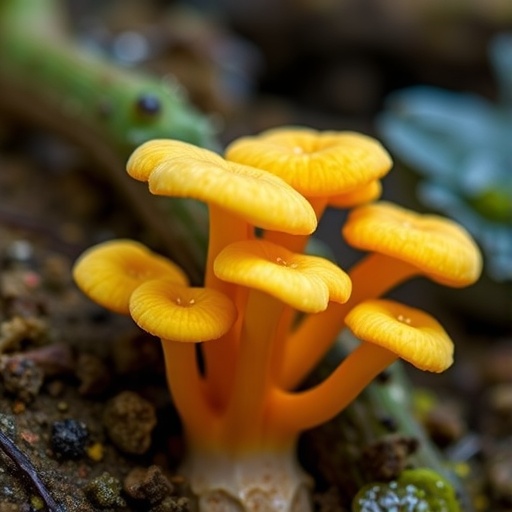In a groundbreaking study, researchers have isolated several new compounds from the filamentous fungus Penicillium chrysogenum, which holds promise for both antibacterial and antifungal applications. Among the discoveries is an indole diketopiperazine named penichrysogenone A, alongside two newly identified natural products, highlighting the untapped potential of fungi as a source of bioactive compounds. This research sheds light on how these natural products could lead to new treatments amidst the rising threat of antibiotic-resistant pathogens.
The discovery of penichrysogenone A marks a significant advancement in the field of natural product chemistry. This compound was meticulously characterized through an array of spectroscopic techniques, allowing the authors to elucidate its complex molecular structure. By employing methodologies such as nuclear magnetic resonance (NMR) spectroscopy, mass spectrometry (MS), and electronic circular dichroism (ECD) calculations, the researchers successfully mapped the intricate configuration of this new compound. Each of these analytical techniques plays a critical role in determining the physical and chemical properties of unknown substances.
This research has sparked interest not only for its scientific rigor but also for the potential implications in medicinal chemistry. Amidst growing concerns regarding antibiotic resistance, the quest for new antibacterial agents is more urgent than ever. Notably, the study found that compound 4 exhibited significant antibacterial properties against Pseudomonas solanacearum, demonstrating a minimum inhibitory concentration (MIC) of 64 micrograms per milliliter. This finding suggests that penicillium-derived compounds could serve as valuable leads in the ongoing battle against bacterial infections.
In addition to its antibacterial properties, the research team also investigated the antifungal potential of the isolated compounds. Among the compounds tested, compound 10 showed remarkable antifungal activity against Candida auris, achieving an MIC of 32 micrograms per milliliter. This result is particularly noteworthy, as C. auris has emerged as a formidable pathogen in healthcare settings, often resistant to multiple antifungal therapies. The efficacy of this compound presents a promising avenue for combating such resistant fungi.
The study did not stop at antibacterial and antifungal investigations; it also included evaluation of the compounds’ antioxidant capabilities. Compounds 2 and 10 demonstrated potent scavenging activity against ABTS radicals, surpassing the effectiveness of the widely recognized antioxidant ascorbic acid. This capability is crucial, as oxidative stress plays a pivotal role in various diseases, and antioxidants have been heralded for their protective roles in health.
As the researchers delve deeper into the capabilities of these newly isolated compounds, they underscore the importance of Penicillium chrysogenum as a biological resource. This fungus, a well-known producer of penicillin, has been previously underexplored, particularly in the context of its secondary metabolites. The insights gained from this study are not only about the compounds themselves; they also speak to the broader objectives of natural product discovery in finding innovative solutions for global health challenges.
The methodology employed in the study serves as a template for future investigations into other fungal species. By isolating and characterizing additional compounds, scientists could uncover a treasure trove of bioactive substances that may possess various therapeutic applications. This is particularly crucial in an era where traditional antibiotics are falling short against evolving bacterial strains. The potential of Penicillium chrysogenum as a wellspring of new medications highlights the urgency of research in this area.
Moreover, the complexities of these natural products demand comprehensive biological evaluations. Understanding how these compounds interact with biological systems is critical for assessing their therapeutic potentials. Follow-up studies will undoubtedly focus on the mechanisms of action, bioavailability, and safety profiles of these newly identified compounds, paving the way for clinical trials and eventual drug development.
Looking forward, the research community is invigorated by the prospects presented by these findings. As more investigations are launched into the vast realm of fungal biology, the likelihood increases of discovering additional compounds with desirable pharmacological profiles. The future of medicine could greatly benefit from innovations derived from fungi, as these organisms are replete with chemistry that humanity has yet to fully exploit.
In summary, this study not only adds to the catalog of known natural products but also reinforces the potential of fungi as a rich source of bioactive compounds. As researchers continue to unravel the complexities of these metabolites, we stand at the cusp of a new era in drug discovery that could reshape how we approach infections and other health issues exacerbated by resistant pathogens.
The innovation and thoroughness seen in this research exemplify the dedicated efforts of scientists to explore nature’s complexities. As the global health landscape shifts and evolves, these compounds could serve as crucial tools in combating the nuanced challenges posed by infectious diseases. This exciting breakthrough is a reminder of the invaluable contributions of natural products in our perpetual fight against illness.
This pioneering work is a testament to the importance of interdisciplinary collaboration in scientific research. By bridging chemistry, biology, and pharmacology, the research team has paved the way for future discoveries that could have substantial impacts on healthcare. As we continue to explore the microbial world, we can only anticipate what other secrets these organisms may hold.
Subject of Research: Natural Products Isolation from Penicillium chrysogenum
Article Title: New indole diketopiperazine from the fungus Penicillium chrysogenum
Article References:
Ji, M., Liu, Q. & Liu, L. New indole diketopiperazine from the fungus *Penicillium chrysogenum*. J Antibiot (2025). https://doi.org/10.1038/s41429-025-00885-w
Image Credits: AI Generated
DOI:
Keywords: Penicillium chrysogenum, penichrysogenone A, antibacterial, antifungal, natural products, drug discovery, oxidative stress, bioactivity.




